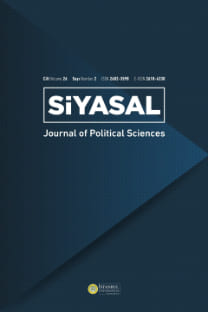A Study on the Capital Structure of the Turkish Real Sector Firms
Türk Reel Sektör Firmalarının Sermaye Yapısı Üzerine Bir Çalışma
___
- Aarstol, M.P., (2000), "Inflation and Debt Maturity", The Quarterly Review of Economics and Finance, V.40, I.I, 139-153
- Barclay, M. J., C. W. Jr., Smith, (1995), "The Maturity Structure of Corporate Debt", Journal of Finance, V.50, 609-631.
- Brealey R., $., Myers, (2000), "Principles of Corporate Finance", 6th ed, McGraw Hill, New York
- Brigham, E., J., Houston, (2004), "Principles of Corporate Finance", 6th ed., McGraw Hill, New York.
- Booth, L.,V., Aivazian, A.. Demirguc-Kunt, V., Maksimovic, (2001), "Capital Structures in Developing Countries", Journal of Finance, V.56, 87-130
- Commision of European Communities, (4.10.2004), "Regular Report on Turkey's Progress towards Accession", http://www.europa.en/enlargement/turkev [Accessed 15.11.2004]
- Caprio, L., A, Demirguc-Kunt, (1997), "The Role of Long Term Finance:Theory and Evidence", The World Bank, Policy Research Department, http://econ.worldbank.org [Accessed 12.02.2004]
- Demirguc-Kunt, A, V., Maksimovic, (2001), "Institutions, Financial Markets and Firm Debt Maturity", Journal of Financial Economics, V.54, 295-336
- De Miguel, A., J., Pindado, (2001), "Determinants of Capital Structure: New Evidence from Spanish Panel Data", Journal of Corporate Finance, V.7, 77-99
- Demirguc- Kunt, A, V., Maksimovic, (1999), "Institutions, Financial Markets, and Firm Debt Maturity", Journal of Financial Economics, V.54,1.3,295-336
- Diamond, D.W., (1991), "Debt Maturity Structure and Liquidity Risk",Quarterly Journal of Economics, V.106, 709-737
- Diamond D. W., R., Rajan, (2000) "Banks, Short Terra Debt and Financial Crises: Theory and Policy Implications", National Bureau of Economic Research (NBER), Working Paper 7764, Cambridge, MA
- Frank, Z.M.,V., Goyal, (2004), "The Effect of Market Conditions on Capital Structure", Finance Research Letters, V. 1.1.1, 47-55
- Fama, E., K., French, (2002), "Testing Trade off and Pecking Order Predictions About Dividends and Debt", Review of Financial Studies, V. 15,I.1,1-34
- Giannetti, M., (2003), "Do Better Institutions Mitigate Agency Problems? Evidence from Corporate Finance Choices", Journal of Financial and Quantitative Analysis, V.38, 185-212
- Gitman, L., (1997), "Principles of Managerial Finance", 8th ed., Addison Wesley, New York
- Gonenc, H.r O., Arslan, (2003), "Türk Reel Sektör Firmalarının Sermaye Yapısına Dayalı Rekabet Gücü: Yurtiçi ve Uluslararsı Firmalar için Karşılaştırmalı bir Analiz" , VII. Ulusal Finans Sempozyumu, İstanbul Üniversitesi, 22-25 Ekim 2003, 293-295
- Guiso, L., P., Sapienza, L., Zingales, (2004), "Does Local Financial Development Matter?", Quarterly Journal of Economics, V.I 19, 929-969
- Heymann, D., A, Leijonhufvud, (1995), "High Inflation", Clarendon Press, Oxford
- Hoi, L., S., Heibatollah, (2004), "The Investment Opportunity Set, Director Ownership and Corporate Policies: Evidence from an Emerging Market",Journal of Corporate Finance, V.10, 383-408
- Hovakimian, A, G., Hovakimian, H., Tehranian, (2004), "Determinants of Target Capital Structure: The Case of Dual Debt and Equity Issues", Journal of Financial Economics, V.71, 517 - 540
- Jensen, M., (1986), "Agency Costs of Free Cash Flow, Corporate Finance and Takeovers", .4mmca/? Economic Review, V.76, 323-329
- Jung, K, Y, Kim, R. Stulz, (1996), "Timing, Investment Opportunities, Managerial Discretion and the Security Issue Decision", Journal of Financial Economics, V.42, 159-185
- Johnson, A.S., (1998), "The Effect of Bank Debt on Optimal Capital Structure", Financial Management, W.21, 47-57
- Khanna, T., K., Palepu, (2000), "Is Group Affiliation Profitable in Emerging Markets? An Analysis of Diversified Indian Business Groups", Journal of Finance, V. 55, N.2, 867-891
- La Porta, R., F., Lopez-De-Silanez, A., Schleifer, R., Visliny, (1998), "Law and Finance", Jowraa/ of Political Economy, V.106, N.6, 1113-1155
- Leland, H., (1994), "Corporate Debt Value, Bond Covenants and Optimal Capital Structure", Journal of Finance,V.52, 1823-1850
- Marsh, P., (1982), "The Choice Between Debt and Equity: An Empirical Study", Journal of Finance, V.37, 121-144
- Miller, V.J., (1992), "Inflation Uncertainty and the Disappearance of financial Markets: The Mexican Example". Journal of Economic Development, V. 17. 131-152
- Mitchell,K.,(1987),"Interest Rate Uncertainty and Corporate Debt Maturity", Journal of Economics and Business. V.39,I.2, 101-114
- Myers. S.C, (1977), "Determinants of Corporate Borrowing", Journal of Financial Economics, V.5, 147-175
- Myers, S.C., (1984), "The Capital Structure Puzzle", Journal of Finance, V.39, 575-592
- Myers, S.C., N.S.,Majluf ,(1984),"Corporate Financing and Investment Decisions When Firms Have Information that Investors do not Have", Journal of Financial Economics, V.I .3, 187-221
- Ozkan, A., (2001), " Determinants of Capita! Structure and Adjustment to Long Run Target", Journal of Business Finance and Accounting, V.28,1.1-2, 175-198
- Rajan,R.G., L., Zingales,(1995),"What Do We Know About Capital Structure? Some Evidence from International Data", Journal of Finance, V.50,1521-1460
- Rajan,R.,L., Zingales,(2003),"Banks and Markets:The Changing Character of European Finance", Working Paper, University of Chicago http://ssrn.com/abstract#225410[Accessed 03.11.2004]
- Smith, CW.Jr.; R.L., Watts, (1992), "The Investment Opportunity Set and Corporate Financing, Dividend and Compensation Policies", Journal of Financial Economics, V.32. 263-292.
- Stulz. R., (1990) "Managerial Discretion and Optimal Financing Policies", Journal of Financial Economics, V.26, 3-27
- ISSN: 1303-1260
- Yayın Aralığı: 2
- Yayıncı: İstanbul Üniversitesi
A Study on the Capital Structure of the Turkish Real Sector Firms
"Batılılaşma" ve "Modernleşme" Üzerine Düşünceler: Tahtavi ve Dostoyevski
ABD'nin Hazar Enerji Politikası ve Türkiye
B. Bulut GÜRPINAR, Abdulkayyum KESİCİ
İnternet Bankacılığında Müşteri Tercihleri Üzerine Bir Araştırma
Melis KARATAŞ, Hüseyin Sabri KURTULDU
Lessons from Best Practices: Japanese Administrative Reforms
Finansal Krizler İçin Erken Uyarı Sistemleri
İdari ve Mali Paylaşım Açısından Merkezi Yönetim Yerel Yönetim İlişkileri
